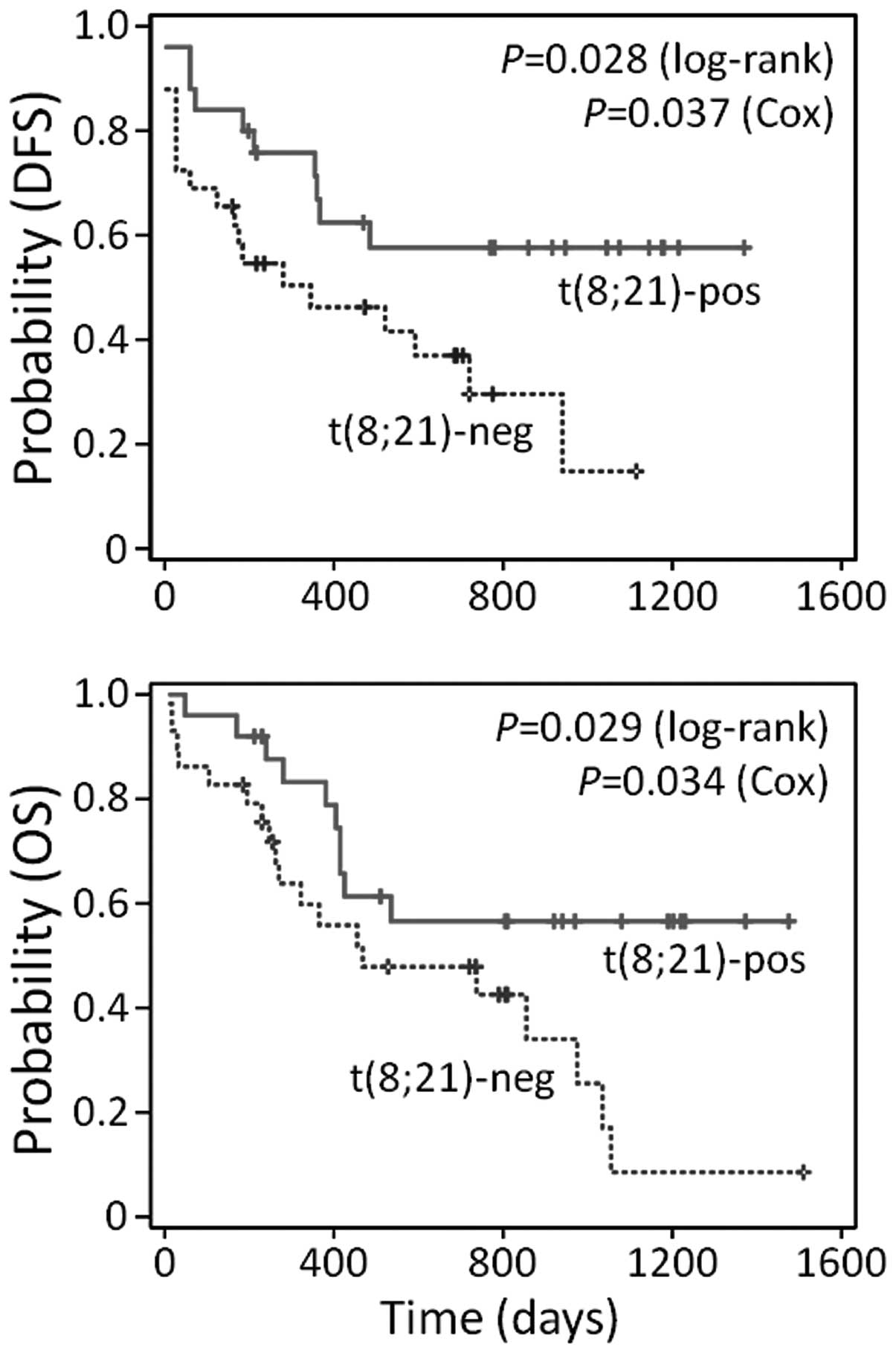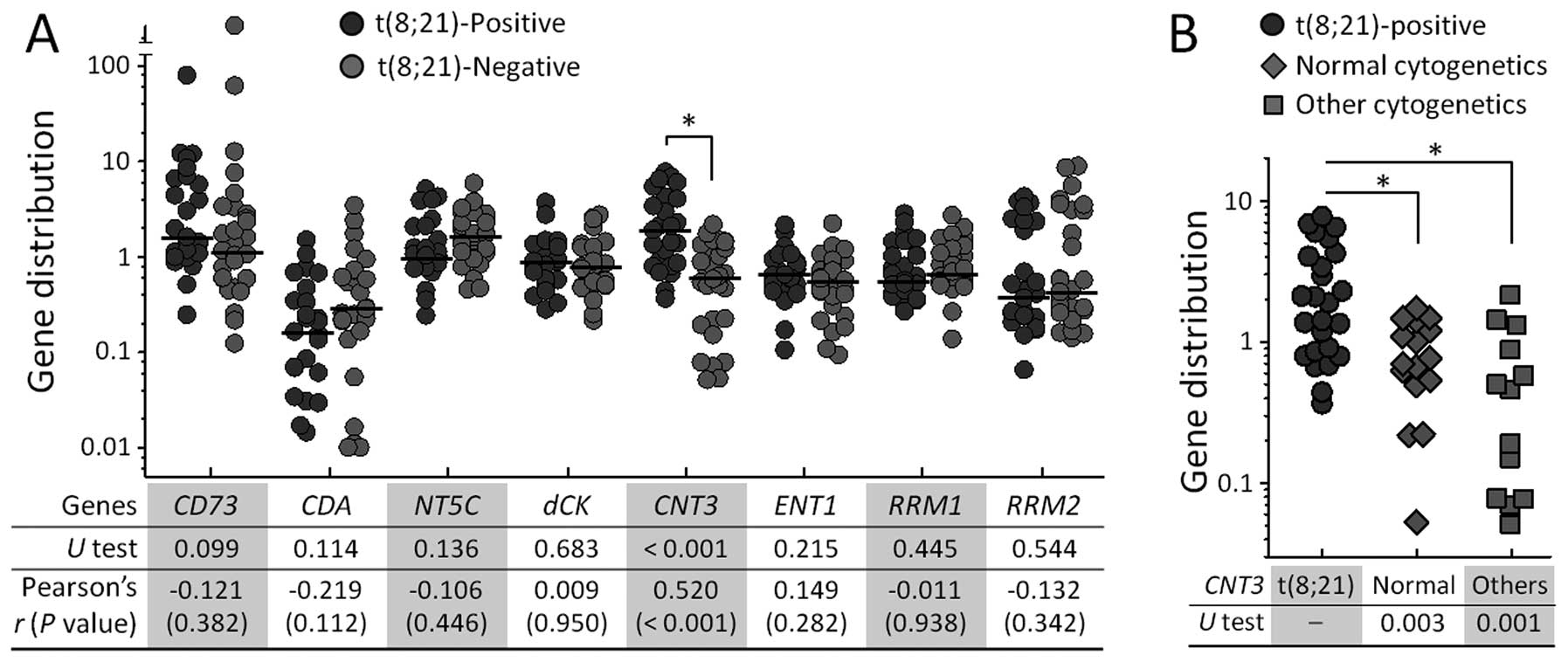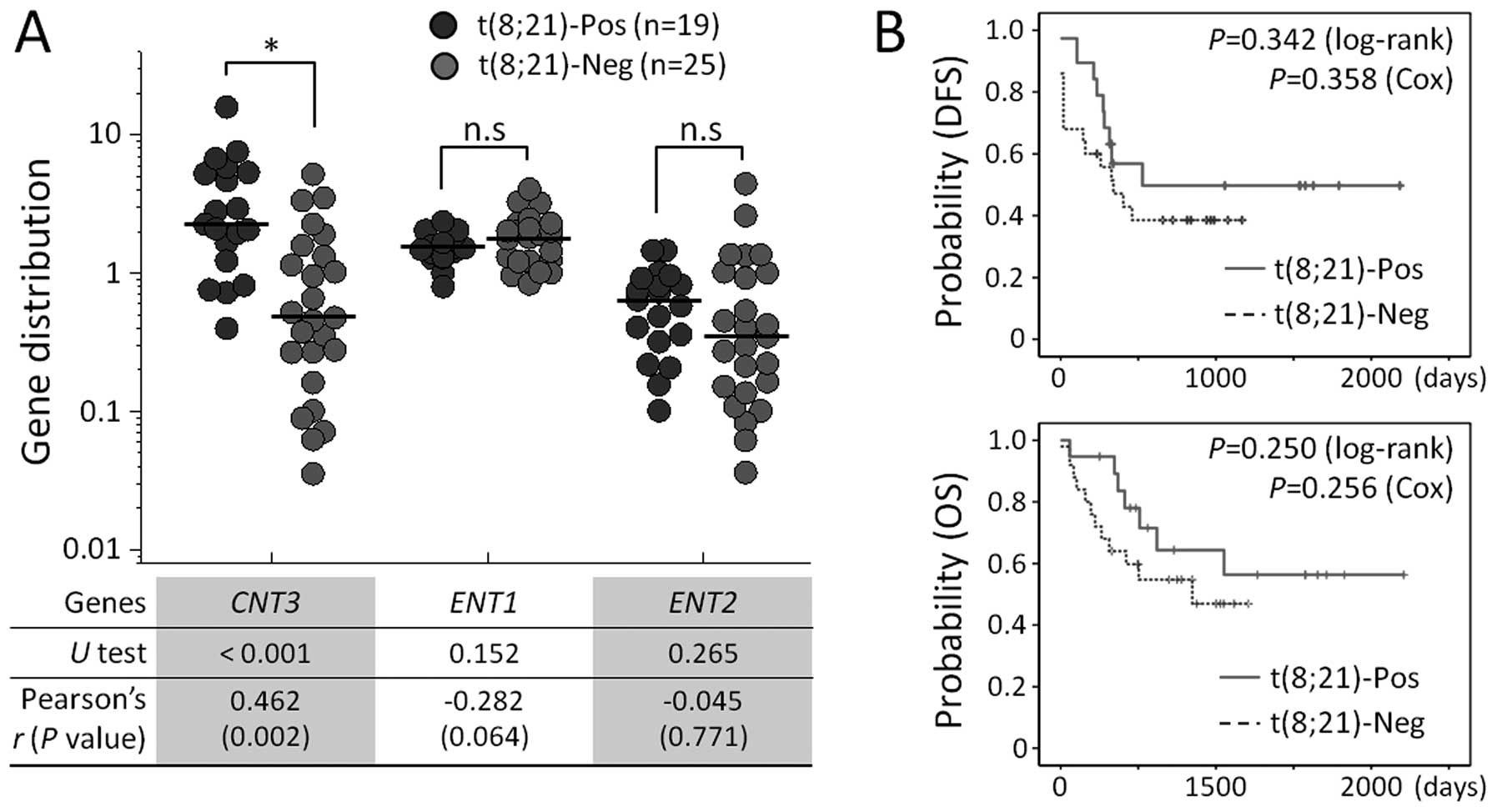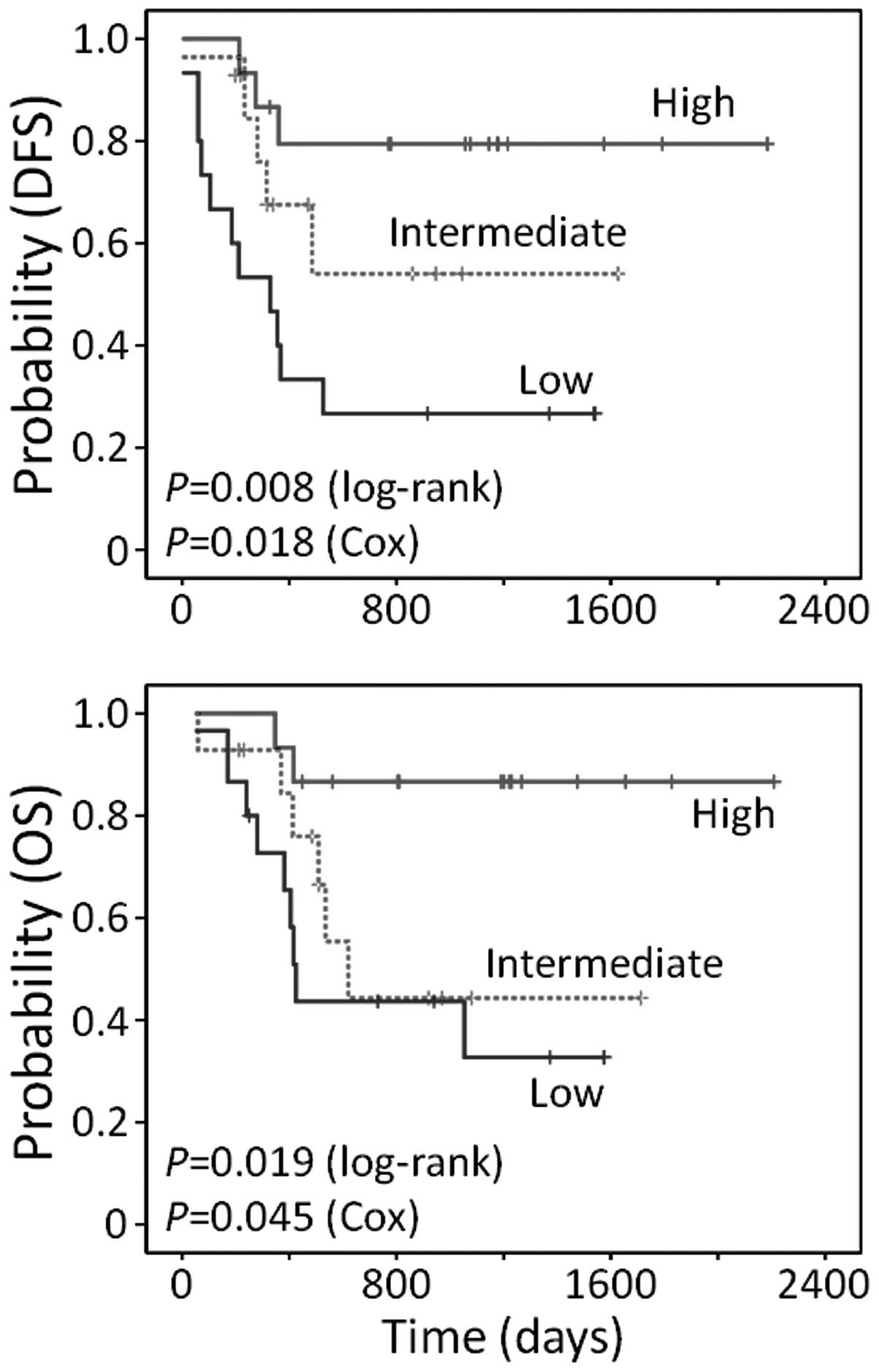|
1
|
Grimwade D, Walker H, Oliver F, Wheatley
K, Harrison C, Harrison G, Rees J, Hann I, Stevens R, Burnett A, et
al The Medical Research Council Adult and Children’s Leukaemia
Working Parties: The importance of diagnostic cytogenetics on
outcome in AML: Analysis of 1,612 patients entered into the MRC AML
10 trial. Blood. 92:2322–2333. 1998.PubMed/NCBI
|
|
2
|
Estey EH: Acute myeloid leukemia: 2012
update on diagnosis, risk stratification, and management. Am J
Hematol. 87:89–99. 2012. View Article : Google Scholar
|
|
3
|
Bloomfield CD, Herzig GP, Peterson BA and
Wolff SN: Long-term survival of patients with acute myeloid
leukemia: Updated results from two trials evaluating postinduction
chemotherapy. Cancer. 80(Suppl): 2186–2190. 1997. View Article : Google Scholar : PubMed/NCBI
|
|
4
|
O’Brien S, Kantarjian HM, Keating M,
Gagnon G, Cork A, Trujillo J and McCredie KB: Association of
granulocytosis with poor prognosis in patients with acute
myelogenous leukemia and translocation of chromosomes 8 and 21. J
Clin Oncol. 7:1081–1086. 1989.
|
|
5
|
Prébet T, Boissel N, Reutenauer S, Thomas
X, Delaunay J, Cahn JY, Pigneux A, Quesnel B, Witz F, Thépot S, et
al Acute Leukemia French Association; Groupe Ouest-Est des
leucémies et autres maladies du sang (GOELAMS); Core Binding Factor
Acute Myeloid Leukemia (CBF AML) intergroup: Acute myeloid leukemia
with translocation (8;21) or inversion (16) in elderly patients
treated with conventional chemotherapy: A collaborative study of
the French CBF-AML intergroup. J Clin Oncol. 27:4747–4753. 2009.
View Article : Google Scholar : PubMed/NCBI
|
|
6
|
Baer MR, Stewart CC, Lawrence D, Arthur
DC, Byrd JC, Davey FR, Schiffer CA and Bloomfield CD: Expression of
the neural cell adhesion molecule CD56 is associated with short
remission duration and survival in acute myeloid leukemia with
t(8;21)(q22;q22). Blood. 90:1643–1648. 1997.PubMed/NCBI
|
|
7
|
Schaich M, Koch R, Soucek S, Repp R,
Ehninger G and Illmer T: A sensitive model for prediction of
relapse in adult acute myeloid leukaemia with t(8;21) using white
blood cell count, CD56 and MDR1 gene expression at diagnosis. Br J
Haematol. 125:477–479. 2004. View Article : Google Scholar : PubMed/NCBI
|
|
8
|
Yang DH, Lee JJ, Mun YC, Shin HJ, Kim YK,
Cho SH, Chung IJ, Seong CM and Kim HJ: Predictable prognostic
factor of CD56 expression in patients with acute myeloid leukemia
with t(8:21) after high dose cytarabine or allogeneic hematopoietic
stem cell transplantation. Am J Hematol. 82:1–5. 2007. View Article : Google Scholar
|
|
9
|
Bloomfield CD, Lawrence D, Byrd JC,
Carroll A, Pettenati MJ, Tantravahi R, Patil SR, Davey FR, Berg DT,
Schiffer CA, et al: Frequency of prolonged remission duration after
high-dose cytarabine intensification in acute myeloid leukemia
varies by cytogenetic subtype. Cancer Res. 58:4173–4179.
1998.PubMed/NCBI
|
|
10
|
Weick JK, Kopecky KJ, Appelbaum FR, Head
DR, Kingsbury LL, Balcerzak SP, Bickers JN, Hynes HE, Welborn JL,
Simon SR, et al: A randomized investigation of high-dose versus
standard-dose cytosine arabinoside with daunorubicin in patients
with previously untreated acute myeloid leukemia: A Southwest
Oncology Group study. Blood. 88:2841–2851. 1996.PubMed/NCBI
|
|
11
|
Schnetzke U, Fix P, Spies-Weisshart B,
Schrenk K, Glaser A, Fricke HJ, La Rosée P, Hochhaus A and Scholl
S: Efficacy and feasibility of cyclophosphamide combined with
intermediate- dose or high-dose cytarabine for relapsed and
refractory acute myeloid leukemia (AML). J Cancer Res Clin Oncol.
140:1391–1397. 2014. View Article : Google Scholar : PubMed/NCBI
|
|
12
|
Damaraju VL, Damaraju S, Young JD, Baldwin
SA, Mackey J, Sawyer MB and Cass CE: Nucleoside anticancer drugs:
The role of nucleoside transporters in resistance to cancer
chemotherapy. Oncogene. 22:7524–7536. 2003. View Article : Google Scholar : PubMed/NCBI
|
|
13
|
Zhang J, Visser F, King KM, Baldwin SA,
Young JD and Cass CE: The role of nucleoside transporters in cancer
chemotherapy with nucleoside drugs. Cancer Metastasis Rev.
26:85–110. 2007. View Article : Google Scholar : PubMed/NCBI
|
|
14
|
Momparler RL and Fischer GA: Mammalian
deoxynucleoside kinase. I. Deoxycytidine kinase: Purification,
properties, and kinetic studies with cytosine arabinoside. J Biol
Chem. 243:4298–4304. 1968.PubMed/NCBI
|
|
15
|
Galmarini CM, Thomas X, Graham K, El
Jafaari A, Cros E, Jordheim L, Mackey JR and Dumontet C:
Deoxycytidine kinase and cN-II nucleotidase expression in blast
cells predict survival in acute myeloid leukaemia patients treated
with cytarabine. Br J Haematol. 122:53–60. 2003. View Article : Google Scholar : PubMed/NCBI
|
|
16
|
Molina-Arcas M, Bellosillo B, Casado FJ,
Montserrat E, Gil J, Colomer D and Pastor-Anglada M: Fludarabine
uptake mechanisms in B-cell chronic lymphocytic leukemia. Blood.
101:2328–2334. 2003. View Article : Google Scholar
|
|
17
|
Song JH, Kim SH, Kweon SH, Lee TH, Kim HJ,
Kim HJ and Kim TS: Defective expression of deoxycytidine kinase in
cytarabine-resistant acute myeloid leukemia cells. Int J Oncol.
34:1165–1171. 2009.PubMed/NCBI
|
|
18
|
Takagaki K, Katsuma S, Kaminishi Y, Horio
T, Nakagawa S, Tanaka T, Ohgi T and Yano J: Gene-expression
profiling reveals down-regulation of equilibrative nucleoside
transporter 1 (ENT1) in Ara-C-resistant CCRF-CEM-derived cells. J
Biochem. 136:733–740. 2004. View Article : Google Scholar
|
|
19
|
Abraham A, Varatharajan S, Abbas S, Zhang
W, Shaji RV, Ahmed R, Abraham A, George B, Srivastava A, Chandy M,
et al: Cytidine deaminase genetic variants influence RNA expression
and cytarabine cytotoxicity in acute myeloid leukemia.
Pharmacogenomics. 13:269–282. 2012. View Article : Google Scholar : PubMed/NCBI
|
|
20
|
Galmarini CM, Cros E, Graham K, Thomas X,
Mackey JR and Dumontet C: 5′-(3′)-nucleotidase mRNA levels in blast
cells are a prognostic factor in acute myeloid leukemia patients
treated with cytarabine. Haematologica. 89:617–619. 2004.PubMed/NCBI
|
|
21
|
Momparler RL, Eliopoulos N, Bovenzi V,
Létourneau S, Greenbaum M and Cournoyer D: Resistance to cytosine
arabi-noside by retrovirally mediated gene transfer of human
cytidine deaminase into murine fibroblast and hematopoietic cells.
Cancer Gene Ther. 3:331–338. 1996.PubMed/NCBI
|
|
22
|
Ujházy P, Berleth ES, Pietkiewicz JM,
Kitano H, Skaar JR, Ehrke MJ and Mihich E: Evidence for the
involvement of ecto-5′-nucleotidase (CD73) in drug resistance. Int
J Cancer. 68:493–500. 1996. View Article : Google Scholar
|
|
23
|
Smid K, Bergman AM, Eijk PP, Veerman G,
van Haperen VW, van den Ijssel P, Ylstra B and Peters GJ:
Micro-array analysis of resistance for gemcitabine results in
increased expression of ribonucleotide reductase subunits.
Nucleosides Nucleotides Nucleic Acids. 25:1001–1007. 2006.
View Article : Google Scholar : PubMed/NCBI
|
|
24
|
Song JH, Kweon SH, Kim HJ, Lee TH, Min WS,
Kim HJ, Kim YK, Hwang SY and Kim TS: High TOP2B/TOP2A expression
ratio at diagnosis correlates with favourable outcome for standard
chemotherapy in acute myeloid leukaemia. Br J Cancer. 107:108–115.
2012. View Article : Google Scholar : PubMed/NCBI
|
|
25
|
Cho EK, Bang SM, Ahn JY, Yoo SM, Park PW,
Seo YH, Shin DB and Lee JH: Prognostic value of AML 1/ETO fusion
transcripts in patients with acute myelogenous leukemia. Korean J
Intern Med. 18:13–20. 2003.PubMed/NCBI
|
|
26
|
Downing JR: The AML1-ETO chimaeric
transcription factor in acute myeloid leukaemia: Biology and
clinical significance. Br J Haematol. 106:296–308. 1999. View Article : Google Scholar : PubMed/NCBI
|
|
27
|
Schaich M, Harbich-Brutscher E, Pascheberg
U, Mohr B, Soucek S, Ehninger G and Illmer T: Association of
specific cytogenetic aberrations with mdr1 gene expression in adult
myeloid leukemia and its implication in treatment outcome.
Haematologica. 87:455–464. 2002.PubMed/NCBI
|
|
28
|
Jin G, Matsushita H, Asai S, Tsukamoto H,
Ono R, Nosaka T, Yahata T, Takahashi S and Miyachi H: FLT3-ITD
induces ara-C resistance in myeloid leukemic cells through the
repression of the ENT1 expression. Biochem Biophys Res Commun.
390:1001–1006. 2009. View Article : Google Scholar : PubMed/NCBI
|
|
29
|
Jordheim LP and Dumontet C: Review of
recent studies on resistance to cytotoxic deoxynucleoside
analogues. Biochim Biophys Acta. 1776:138–159. 2007.PubMed/NCBI
|
|
30
|
Mackey JR, Galmarini CM, Graham KA, Joy
AA, Delmer A, Dabbagh L, Glubrecht D, Jewell LD, Lai R, Lang T, et
al: Quantitative analysis of nucleoside transporter and metabolism
gene expression in chronic lymphocytic leukemia (CLL):
Identification of fludarabine-sensitive and -insensitive
populations. Blood. 105:767–774. 2005. View Article : Google Scholar
|
|
31
|
Guo Y, Köck K, Ritter CA, Chen ZS, Grube
M, Jedlitschky G, Illmer T, Ayres M, Beck JF, Siegmund W, et al:
Expression of ABCC-type nucleotide exporters in blasts of adult
acute myeloid leukemia: Relation to long-term survival. Clin Cancer
Res. 15:1762–1769. 2009. View Article : Google Scholar : PubMed/NCBI
|
|
32
|
Griffiths M, Beaumont N, Yao SY, Sundaram
M, Boumah CE, Davies A, Kwong FY, Coe I, Cass CE, Young JD, et al:
Cloning of a human nucleoside transporter implicated in the
cellular uptake of adenosine and chemotherapeutic drugs. Nat Med.
3:89–93. 1997. View Article : Google Scholar : PubMed/NCBI
|
|
33
|
Hubeek I, Stam RW, Peters GJ, Broekhuizen
R, Meijerink JP, van Wering ER, Gibson BE, Creutzig U, Zwaan CM,
Cloos J, et al: The human equilibrative nucleoside transporter 1
mediates in vitro cytarabine sensitivity in childhood acute myeloid
leukaemia. Br J Cancer. 93:1388–1394. 2005. View Article : Google Scholar : PubMed/NCBI
|
|
34
|
Ritzel MW, Ng AM, Yao SY, Graham K, Loewen
SK, Smith KM, Ritzel RG, Mowles DA, Carpenter P, Chen XZ, et al:
Molecular identification and characterization of novel human and
mouse concentrative Na+-nucleoside cotransporter
proteins (hCNT3 and mCNT3) broadly selective for purine and
pyrimidine nucleosides (system cib). J Biol Chem. 276:2914–2927.
2001. View Article : Google Scholar
|
|
35
|
Galmarini CM, Thomas X, Calvo F, Rousselot
P, El Jafaari A, Cros E and Dumontet C: Potential mechanisms of
resistance to cytarabine in AML patients. Leuk Res. 26:621–629.
2002. View Article : Google Scholar : PubMed/NCBI
|
|
36
|
Stam RW, den Boer ML, Meijerink JP, Ebus
ME, Peters GJ, Noordhuis P, Janka-Schaub GE, Armstrong SA,
Korsmeyer SJ and Pieters R: Differential mRNA expression of
Ara-C-metabolizing enzymes explains Ara-C sensitivity in MLL
gene-rearranged infant acute lymphoblastic leukemia. Blood.
101:1270–1276. 2003. View Article : Google Scholar
|
|
37
|
Fotoohi AK, Lindqvist M, Peterson C and
Albertioni F: Involvement of the concentrative nucleoside
transporter 3 and equilibrative nucleoside transporter 2 in the
resistance of T-lymphoblastic cell lines to thiopurines. Biochem
Biophys Res Commun. 343:208–215. 2006. View Article : Google Scholar : PubMed/NCBI
|
|
38
|
Karim H, Hashemi J, Larsson C, Moshfegh A,
Fotoohi AK and Albertioni F: The pattern of gene expression and
gene dose profiles of 6-Mercaptopurine- and 6-Thioguanine-resistant
human leukemia cells. Biochem Biophys Res Commun. 411:156–161.
2011. View Article : Google Scholar : PubMed/NCBI
|
|
39
|
Verhaak RG, Wouters BJ, Erpelinck CA,
Abbas S, Beverloo HB, Lugthart S, Löwenberg B, Delwel R and Valk
PJ: Prediction of molecular subtypes in acute myeloid leukemia
based on gene expression profiling. Haematologica. 94:131–134.
2009. View Article : Google Scholar :
|
|
40
|
Balgobind BV, Van den Heuvel-Eibrink MM,
De Menezes RX, Reinhardt D, Hollink IH, Arentsen-Peters ST, van
Wering ER, Kaspers GJ, Cloos J, de Bont ES, et al: Evaluation of
gene expression signatures predictive of cytogenetic and molecular
subtypes of pediatric acute myeloid leukemia. Haematologica.
96:221–230. 2011. View Article : Google Scholar :
|
|
41
|
Ichikawa H, Tanabe K, Mizushima H, Hayashi
Y, Mizutani S, Ishii E, Hongo T, Kikuchi A and Satake M: Common
gene expression signatures in t(8;21)- and inv(16)-acute myeloid
leukaemia. Br J Haematol. 135:336–347. 2006. View Article : Google Scholar : PubMed/NCBI
|
|
42
|
Duflot S, Riera B, Fernández-Veledo S,
Casadó V, Norman RI, Casado FJ, Lluís C, Franco R and
Pastor-Anglada M: ATP-sensitive K+ channels regulate the
concentrative adenosine transporter CNT2 following activation by
A1 adenosine receptors. Mol Cell Biol. 24:2710–2719.
2004. View Article : Google Scholar : PubMed/NCBI
|
|
43
|
Fernández-Veledo S, Valdés R, Wallenius V,
Casado FJ and Pastor-Anglada M: Up-regulation of the high-affinity
pyrimidine-preferring nucleoside transporter concentrative
nucleoside transporter 1 by tumor necrosis factor-alpha and
interleukin-6 in liver parenchymal cells. J Hepatol. 41:538–544.
2004. View Article : Google Scholar : PubMed/NCBI
|
|
44
|
Soler C, Felipe A, García-Manteiga J,
Serra M, Guillén-Gómez E, Casado FJ, MacLeod C, Modolell M,
Pastor-Anglada M and Celada A: Interferon-gamma regulates
nucleoside transport systems in macrophages through signal
transduction and activator of transduction factor 1
(STAT1)-dependent and -independent signalling pathways. Biochem J.
375:777–783. 2003. View Article : Google Scholar : PubMed/NCBI
|


















